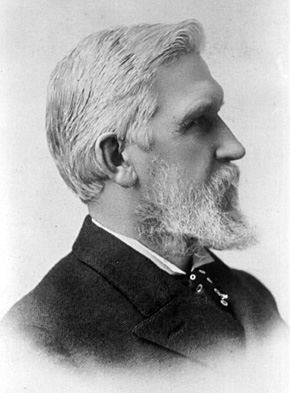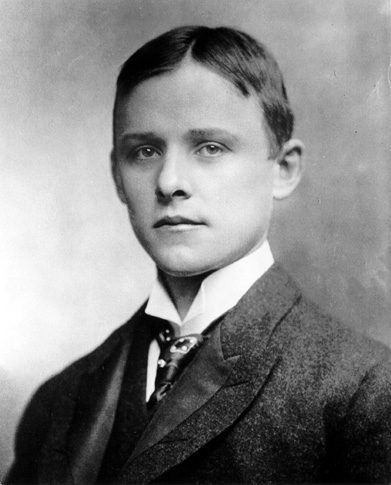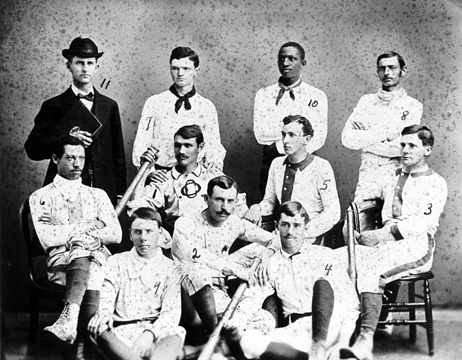When Oberlin first began in 1833, townspeople had to depend on their own skills and talents to provide the goods and services they needed. Oberlin's first settlers did not see any paved roads, stores, or telephone poles. They were greeted by many natural riches. These riches included the trees and wild game animals in the forest; the clean water and fish in the streams; the stone, the clay, the natural gas, and the rich soil in the ground. The colonists made use of the natural resources of the area through hard work and cooperation.
In order to survive, food and shelter had to be the first business of the colony. By the end of 1833, on the banks of the Plum Creek, Oberlin had a sawmill that cut trees into lumber and a gristmill that ground corn and wheat into flour.
Originally Pastor Shipherd and Mr. Stewart's plan was for the college to own and operate all the businesses in the colony. They thought this would prevent any type of cheating or greed. Oberlin College students could work there for their required "four hours daily" of labor. However, the college could not afford the expenses of both the colony businesses and the school. Within a few years, the college sold its mills and local entrepreneurs took over.
In the late 1830's Oberlin College tried an experiment in an effort to help the school earn money to support itself. The Oberlin College trustees gave Pastor Shipherd permission to buy mulberry trees. They hoped that someday these trees could be used by silkworms to spin the fibers from which silk is made. Oberlinians could work in factories where silk fibers would be made into cloth and clothing.
It is said that 39,105 trees were planted, but most were eaten by roving cattle or killed by dry weather. The silk dream vanished.
Mills, factories, and trade shops were located on Mill Street, Water Street, South Pleasant Street, and South Main Street. In the Plum Creek area from 1833 until the early 1900's, you might have seen a Blacksmith Shop, a Cabinet-making Shop, a Cloth-making Factory, a Furniture Factory, a Gristmill, a Sawmill, a Shingle Mill, a Buggy Shop, or a Window-Blind Factory. These businesses disappeared when the services were no longer needed and as competition from the world outside became too great.
You can easily find South Pleasant Street and South Main Street in Oberlin today, but Mill Street was renamed Vine Street and Water Street became Park Street.
- Division of Wildlife
- Division of Forestry
- Division of Forestry Urban Forestry Assistance Program
At first, the college sold to the colonists, teachers, and students, many of the things they needed. But soon after the colony began, T. S. Ingersall began to sell things from his home. He soon built a general store in the downtown area. Most businesses were in homes, however, so growth in the downtown area was slow. Beginning in the 1850's, the stores and shops of local entrepreneurs began to spring up downtown as more people moved into Oberlin. In 1895, an advertisement for Oberlin listed 142 businesses.
One business that has been in Oberlin since the town began in 1833 is a hotel, in one form or another, where the Oberlin Inn is now. When Brewster Pelton built a log cabin in 1833 on that spot, he offered a place for strangers to stay overnight. In 1834, Mr. Pelton built a new two-story hotel there. The Oberlin Inn, built in 1955, is the fourth hotel built on that location.
"Gibson's Bakery" is the oldest family business in town. Since 1888, townspeople, college students, and visitors have enjoyed goodies from Gibson's on West College Street.
There has been a Watson Hardware Store in Oberlin since 1894. Other owners have kept the name from the first owner, Miles J. Watson .
Some of the early businesses in Oberlin were owned by African-Americans. Blacksmith Allen Jones and his family came to Oberlin in 1843 just in time to help make the iron work for First Church. His blacksmith shop stood opposite the church site. John Watson came to Oberlin with his family from Louisiana where they had been slaves. By 1852 he was able to erect a building on South Main Street where he operated a grocery store and restaurant for 20 years. Henry and Wilson Evans came to Oberlin in 1854 and established a cabinet-making shop on what is now Vine Street.
For many years after the mills and factories disappeared from the Plum Creek area, large scale industrial development by-passed Oberlin.
Then in 1958, the Federal Aviation Administration (FAA) contacted the city of Oberlin. The FAA needed to build a new control center where Air-Traffic Controllers would use radar and electronic equipment to make sure that airplanes didn't fly in pathways that could lead to mid-air accidents. A piece of land in the northeast section of the city, off East Lorain Street, was just what the FAA needed.
By 1961, the Cleveland Air Traffic Control Center had moved to Oberlin. The building cost the FAA $1,900,000 to build. The electric equipment cost $15,000,000. The Oberlin FAA Center has become one of the largest and busiest control centers in the world.
Soon some Oberlin businessmen began having thoughts of an "industrial park" on the land next to the FAA. The Oberlin City Council and other Oberlin citizens were interested in bringing "clean" industries to Oberlin that wouldn't cause pollution of the environment. These industries would bring in new tax money to help run the city and provide more jobs for townspeople. Thanks to much planning and hard work, Oberlin now has a publicly owned, 88 acre, industrial park.
As of 1995, the Oberlin Industrial Park occupants are:
Express Seed Company packages seeds that sell in stores.
Wolfe Envelope Company makes envelopes.
Ciba-Corning Diagnostics makes equipment for doctors and hospitals that can help find out, or diagnose, what might be wrong with a patient.
Hydro-Tube does bending, machining, and fabrication of metal. It makes high-pressure hydraulic hoses and piping for industry.
Servicemaster provides cleaning services for homes or businesses.
Alden Press does commercial printing.
Murray Ridge Center is a training center where people with disabilities do hand-assembly and packaging work for local businesses.
Just east of the industrial park is the national headquarters of a company called NACS (National Association of College Stores). Every year more than 4,000,000 books are shipped from these buildings in Oberlin to college bookstores all over this country.
More than 1,000 people have jobs in the Oberlin Industrial Park, the FAA, and NACS.
Many people in Oberlin work in places that provide services instead of goods. For example, Oberlin College, the Oberlin Clinic, the City of Oberlin, the Oberlin School District, and Kendal at Oberlin all employ many people.
In 1985, the City of Oberlin and the downtown merchants began sprucing up the downtown area. The City put in new water lines and sewers. Brick-accented sidewalks, potted plants, benches, and old fashioned lampposts made the 60-store area more attractive. The storekeepers paid for the improvements of their storefronts. The city and the merchants want Oberlin to stay a good place for business.
Did you ever hear the old expression that goes, "Necessity is the mother of invention"? This means that inventions and discoveries often grow out of a need for an improvement in someone's life situation. Many Oberlinians have solved problems they set for themselves and become successful inventors.
After helping to found the Oberlin Colony, Philo Stewart worked hard to make a really good wood-burning stove for cooking. This "Oberlin Stove", became popular in many frontier homes. In 1844-1845, about 7,800 were made and sold for about $22 each. Mr. Stewart donated some of the money earned from the sales of his stoves to Oberlin College.
 Another
inventor from Oberlin was Elisha
Gray who attended Oberlin Preparatory School and College. In
1866, Mr. Gray invented an instrument that improved the telegraph
system of that time. A telegraph sends messages by a pattern of
sounds. Gray's "self-adjusting relay" automatically regulated the
motions of the telegraph machine. Mr. Gray applied for a patent for
"an apparatus for transmitting vocal sounds telegraphically" on the
same day in 1876 that Alexander Graham Bell applied for a patent for
his "electric speaking telephone." The two inventions were so similar
that the patent office asked the men for further information. Mr.
Gray decided to put his energy into another invention for the
telegraph and Mr. Bell received the patent. It was later discovered
that the apparatus described by Gray would have worked, while that in
Bell's patent did not. Bell was legally named the inventor of the
telephone by the courts after each challenge. Gray's company Western
Electric ended up becoming the manufacturer of Bell's telephone
equipment.
Another
inventor from Oberlin was Elisha
Gray who attended Oberlin Preparatory School and College. In
1866, Mr. Gray invented an instrument that improved the telegraph
system of that time. A telegraph sends messages by a pattern of
sounds. Gray's "self-adjusting relay" automatically regulated the
motions of the telegraph machine. Mr. Gray applied for a patent for
"an apparatus for transmitting vocal sounds telegraphically" on the
same day in 1876 that Alexander Graham Bell applied for a patent for
his "electric speaking telephone." The two inventions were so similar
that the patent office asked the men for further information. Mr.
Gray decided to put his energy into another invention for the
telegraph and Mr. Bell received the patent. It was later discovered
that the apparatus described by Gray would have worked, while that in
Bell's patent did not. Bell was legally named the inventor of the
telephone by the courts after each challenge. Gray's company Western
Electric ended up becoming the manufacturer of Bell's telephone
equipment.

Probably Oberlin's most famous inventor was Charles Martin Hall who figured out a cheap way to extract aluminum from the ore called bauxite. In 1886 in his family's home on the northwest corner of College Street and Pleasant Street, Mr. Hall discovered that by putting the ore in a certain chemical solution and sending electricity through it, the aluminum was separated from the bauxite.
Aluminum is a very useful, light in weight, easily-molded, non-rusting metal. Many uses were found for it and it is now very much a part of our everyday modern life. Mr. Hall founded ALCOA (the Aluminum Company of America) to manufacture aluminum.
Upon his death in 1914, Mr. Hall shared his wealth by leaving Oberlin College $12,000,000. Hall Auditorium was built in honor of his mother. He also left money to take care of Tappan Square so that it could always be a park.
After his graduation from Oberlin College in 1882, Moses Fleetwood Walker became the first professional African American baseball player in the United States. When his career ended in 1891, he turned to invention. Along with several partners, he received a patent for a dynamite artillery shell that exploded on impact. Mr. Walker's shell became out-of-date within ten years when a new invention, a rapid-fire gun, took its place.

One Oberlin invention may be a favorite of yours. The delicious hot-fudge sundae was invented by Phil H. Ohly in 1911 at the soda fountain in his downtown drug store.
The people who continue to make things, sell things, grow things, provide services, and invent things, all contribute to keeping Oberlin a comfortable place to live.
Pretend you're living in Oberlin in 1865 and you're old enough to choose a career. What job in Oberlin would you choose? Where would you work and what would you do there? Why would you make this choice?
If you were ready to choose a career in present day Oberlin, what job would you choose? Where would you work and what would you do there? Why would you make this choice?
Is there a career that you might choose for which you would have to work outside of Oberlin, but you could still live in or near Oberlin?
Is there a career that you might choose for which you would have to leave the Oberlin area?
Oberlin: Yesterday, Today, Tomorrow Home
Page | Table of Contents | ![]()
![]()